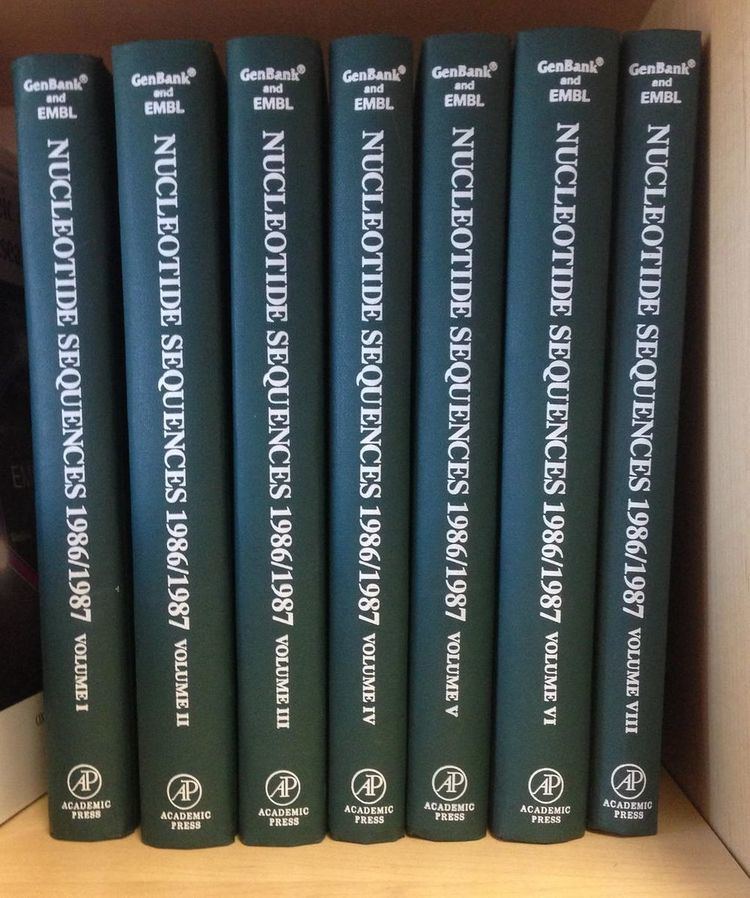Organisms All Primary citation PMID 21071399 | Research center NCBI | |
 | ||
Description Nucleotide sequences for more than 300,000 organisms with supporting bibliographic and biological annotation. Data typescaptured Nucleotide sequenceProtein sequence Release date 1982; 35 years ago (1982) | ||
The GenBank sequence database is an open access, annotated collection of all publicly available nucleotide sequences and their protein translations. This database is produced and maintained by the National Center for Biotechnology Information (NCBI) as part of the International Nucleotide Sequence Database Collaboration (INSDC). The National Center for Biotechnology Information is a part of the National Institutes of Health in the United States. GenBank and its collaborators receive sequences produced in laboratories throughout the world from more than 100,000 distinct organisms. In more than 30 years since its establishment, GenBank has become the most important and most influential database for research in almost all biological fields, whose data are accessed and cited by millions of researchers around the world. GenBank continues to grow at an exponential rate, doubling every 18 months. Release 194, produced in February 2013, contained over 150 billion nucleotide bases in more than 162 million sequences. GenBank is built by direct submissions from individual laboratories, as well as from bulk submissions from large-scale sequencing centers.
Contents
Submissions
Only original sequences can be submitted to GenBank. Direct submissions are made to GenBank using BankIt, which is a Web-based form, or the stand-alone submission program, Sequin. Upon receipt of a sequence submission, the GenBank staff examines the originality of the data and assigns an accession number to the sequence and performs quality assurance checks. The submissions are then released to the public database, where the entries are retrievable by Entrez or downloadable by FTP. Bulk submissions of Expressed Sequence Tag (EST), Sequence-tagged site (STS), Genome Survey Sequence (GSS), and High-Throughput Genome Sequence (HTGS) data are most often submitted by large-scale sequencing centers. The GenBank direct submissions group also processes complete microbial genome sequences.
History
Walter Goad of the Theoretical Biology and Biophysics Group at Los Alamos National Laboratory and others established the Los Alamos Sequence Database in 1979, which culminated in 1982 with the creation of the public GenBank. Funding was provided by the National Institutes of Health, the National Science Foundation, the Department of Energy, and the Department of Defense. LANL collaborated on GenBank with the firm Bolt, Beranek, and Newman, and by the end of 1983 more than 2,000 sequences were stored in it.
In the mid 1980s, the Intelligenetics bioinformatics company at Stanford University managed the GenBank project in collaboration with LANL. As one of the earliest bioinformatics community projects on the Internet, the GenBank project started BIOSCI/Bionet news groups for promoting open access communications among bioscientists. During 1989 to 1992, the GenBank project transitioned to the newly created National Center for Biotechnology Information.
Growth
The GenBank release notes for release 162.0 (October 2007) state that "from 1982 to the present, the number of bases in GenBank has doubled approximately every 18 months".
As of 15 June 2016, GenBank release 214.0 has 194,463,572 loci, 213,200,907,819 bases, from 194,463,572 reported sequences.
The GenBank database includes additional data sets that are constructed mechanically from the main sequence data collection, and therefore are excluded from this count.
Incomplete identifications
Public databases, such as GenBank, which may be searched using the National Center for Biotechnology Information Basic Local Alignment Search Tool (NCBI BLAST), lack peer-reviewed sequences of type strains and sequences of non-type strains. On the other hand, while commercial databases potentially contain high-quality filtered sequence data, there are a limited number of reference sequences.
A paper released in the Journal of Clinical Microbiology evaluated the 16S rRNA gene sequencing results analyzed with GenBank in conjunction with other freely available, quality-controlled, web-based public databases, such as the EzTaxon-e (http://eztaxon-e.ezbiocloud.net/) and the BIBI (http://pbil.univ-lyon1.fr/bibi/) databases. The results showed that analyses performed using GenBank combined with EzTaxon-e (kappa = 0.79) were more discriminative than using GenBank (kappa = 0.66) or other databases alone.
